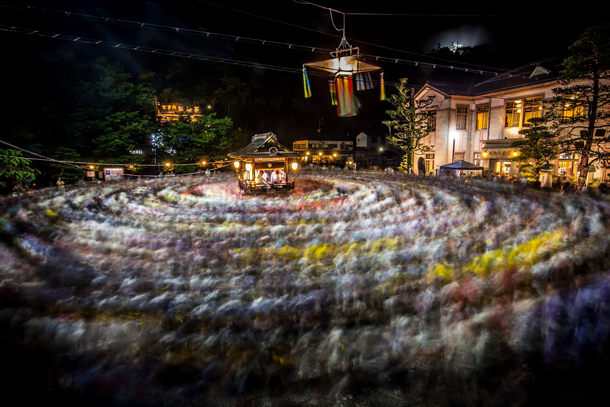
The Gujo Odori dance festival is one of the three most important traditional bon dance festivals in Japan, and it is also one of the most accessible. Already designated a Significant Intangible Cultural Folk Asset by the Japanese government, Gujo Odori was added to UNESCO's Intangible Cultural Heritage List in late 2022. Gujo Odori should not be missed!
Gujo Odori consists of ten dances and corresponding songs. The most famous and well known is "Kawasaki". Many Japanese people will sing this song to you when you mention that you have been to Gujo Hachiman.
The second most well known and loved song is "Haru Koma" or Spring Horse. The dance is characterized by energetic movements mimicking a leaping and bucking horse with rider. You can learn more about each dance, and see videos of how to dance all ten Gujo Odori dances near the bottom of this page.
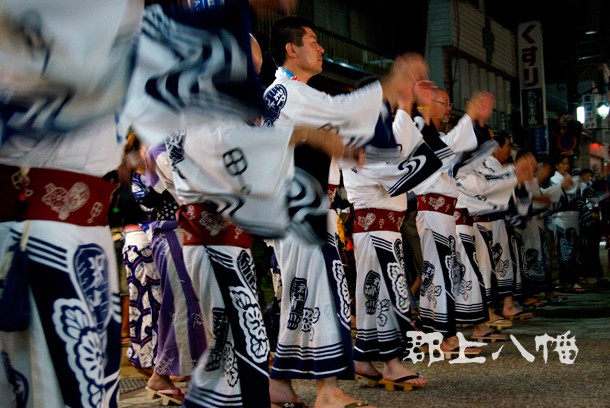
Endo Yoshitaka started the Gujo Odori festival in the Tokugawa Period over 400 years ago. This was an attempt to encourage all the town's citizens to get together, regardless of social level or position. This spirit remains today as the heart and soul of this very popular summer bon dance festival.
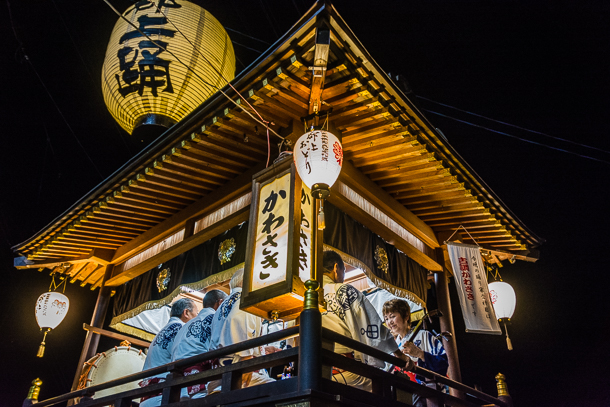
Gujo Odori is always performed live by a small group of singers and musicians sitting in a small float located in the center of the dancing circle. The instruments used vary by song, and include the shamisen, bamboo flute, and taiko drum. The name of the song currently being performed is displayed on lit lanterns at the corners of the float. The singers and musicians will change over the course of an evening, and many have been playing and singing for many years.
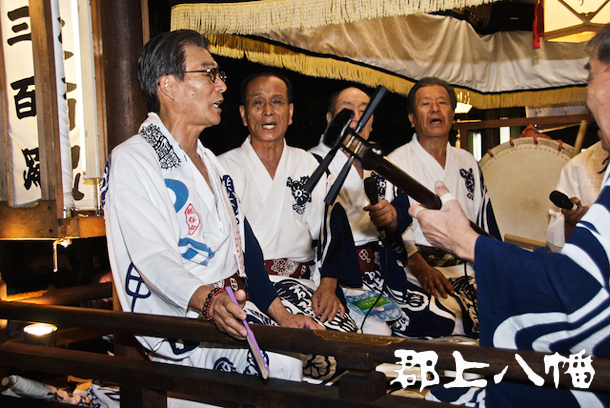
Members of the Gujo Odori Preservation Society perform the music and songs of Gujo Odori live in a tradition that has been passed down for centuries.
Below is a short Q and A to help visitors make the most of their Gujo Odori experience.
A. Gujo Odori is typically held on over 30 festive nights, from mid-July until the first weekend in September. During this time, tens of thousands of people dance the ten traditional bon odori dances of the festival in the streets throughout the town.

For many, the most exciting time is "tetsuya odori" held on the four nights of the festival during "obon" in the middle of August. These are the nights when revellers dance from sunset until the morning sun begins to rise above the surrounding mountains.
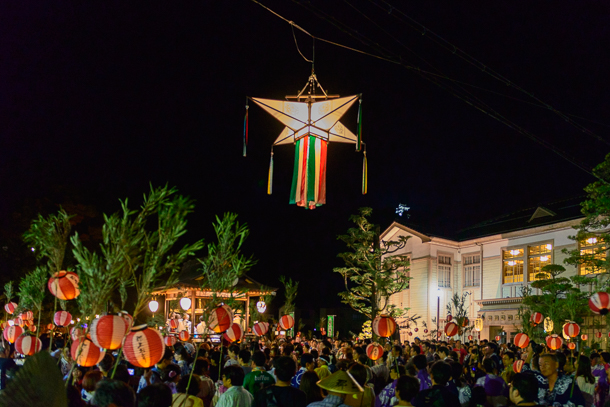
Everyone is welcome and encouraged to join in, and there are always plenty of people eager to teach anyone interested in participating.
A. Locations for each day often change, and follow an historic and traditional pattern whereby dancing takes place near certain temples and shrines over the period of the festival. The dance locations are not difficult to find, and are indicated on the dance schedule.
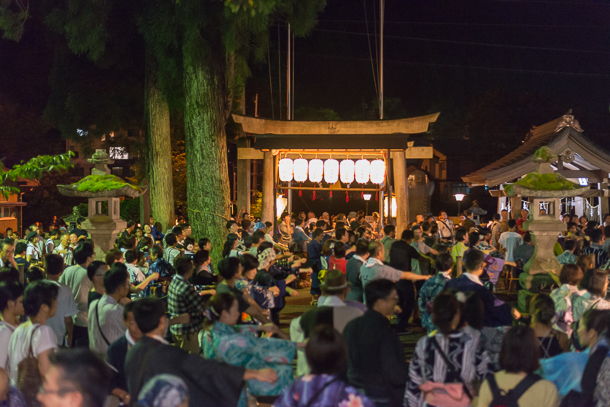
A. On many evenings, especially at the week-ends, the crowd of dancers can be quite large and the streets where Gujo Odori is danced can be very crowded. It is not uncommon for crowds to exceed 30,000 people during each of the four nights of tetsuya Odori at obon in August.
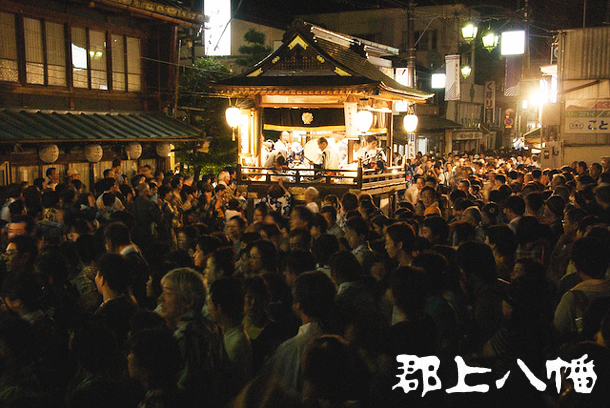
Consequently accommodation can be difficult to reserve for many nights of the festival. For visitors preferring a less crowded Gujo Odori experience, plan to visit mid-week before mid-August, or near the end of August.
A. For an "authentic" experience you can wear the light cotton traditional yukata and wooden gaeta sandals you will find in your room at all ryokans, or can rent from local kimono stores. Jeans, T-shirts and sneakers are just as welcome! The point is to have fun, make new friends, and experience traditional Japan in a way that is unique to Gujo Hachiman.
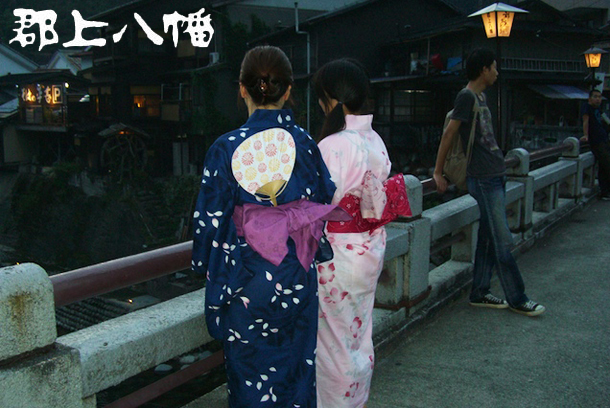
Visitors wearing traditional cotton yukata pause on Miyagase bridge to contemplate the lanterns lit along the Yoshida River before going to dance Gujo Odori.
All Gujo Odori dances consist of simple rhythmic motions that combine simple hand movements with easy to follow foot patterns. All dancers follow an imaginary circle rotating in a clockwise direction around the singers and musicians, except "Gen Gen Bala Bala" which is danced in a counter-clockwise direction. More experienced dancers tend to dance more "inside the circle" and towards the middle of the street, while less experienced dancers tend to gravitate to the outside of the circle closer to the edge of the street.
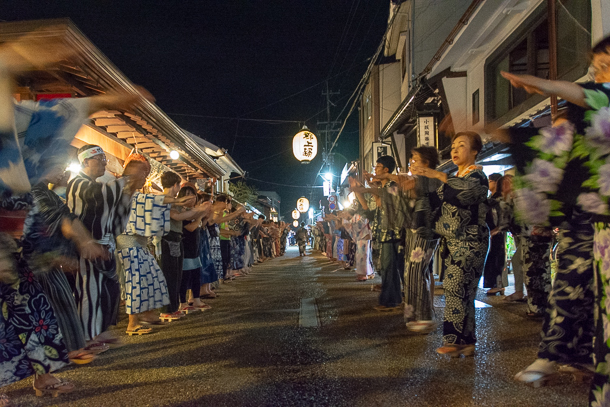
Some dance movements mimic simple farmer movements like throwing a tied bale of rice, or pulling up strings attached to your gaeta to help walk through the mud. Other dance movements are a little more sophisticated, but are typically simple, rhythmic and repeated throughout the dance.
It's quite easy to learn Gujo Odori by watching others dance, and locals will almost always offer to show you how to dance. Many dances feature very simple rhythmic movements.
The Gujo Hachiman Hakurankan offers lessons daily at 11 a.m., 12 p.m. 1 p.m. 2 p.m. and 3 p.m. There are additional classes at 10 am and 4 p.m. on Saturdays and Sundays. The lessons feature the most important dances - Kawasaki and/or Haru Koma and are about 15 minutes in duration. Adult Admission:520 JPY Children 310 JPY. Entry to the gift shop is free. Open daily except for New Year's holiday.
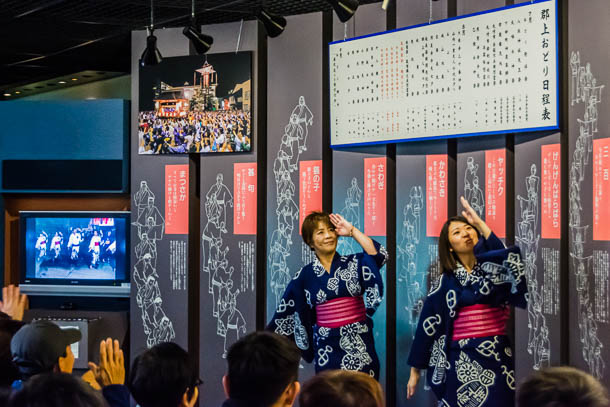
Find out more about the Gujo Odori Presentation.
The singers and musicians will typically vary the pace of each dance according to how they see the crowd respond. On evenings where the crowd is energetic, you can expect quickly paced songs followed by slower paced songs that let dancers recover.
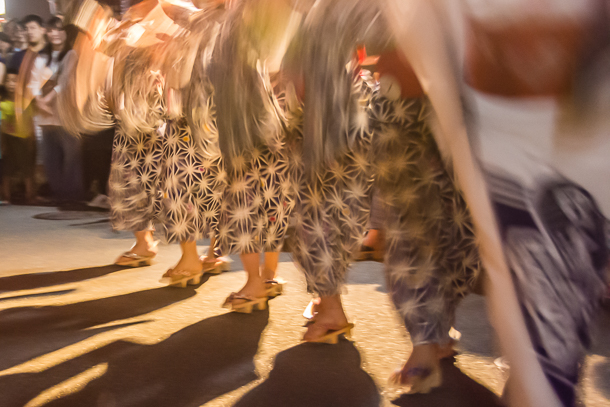
It's not uncommon to experience a "runner's high" on energetic nights, so dancers who prefer a slower and more leisurely pace will join at their leisure and often skip the more fast-paced dances.
Keep in mind, however, that Gujo Odori is danced by all ages - from small children, to men and women sometimes well into their 80s!
Many bars and restaurants are open during the nighs when Gujo Odori is danced and it's common to take a break and enjoy a snack or drink while others dance.
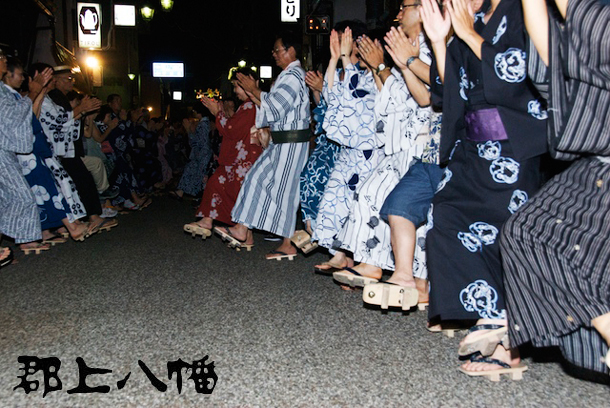
A. Both men and women dance the same same movements in the same way. Typically many men participate in Gujo Odori and it is not uncommon to see long lines of men dancing.
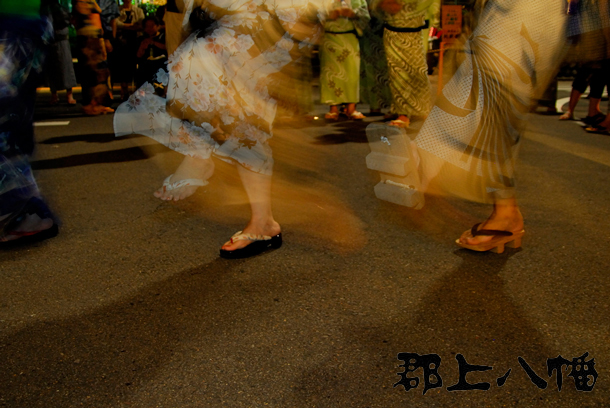
Gujo Odori certificates are awarded each night of dancing to a select few who demonstrate exceptional technique. The number of coveted Gujo Odori certificates issued each day is a closely guarded secret. It is unfortunately not possible to buy a certificate, but put your best foot forward and you may find yourself a recipient of one of these treasured certificates!
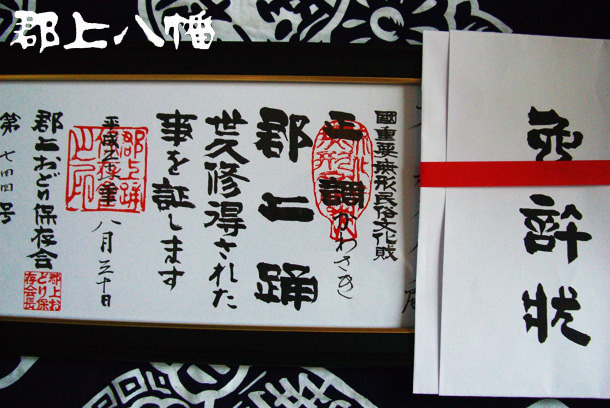
A coveted Gujo Odori dancing certificate of accomplishment.
A. Gujo Odori is danced regardless of the weather, rain or shine, and is cancelled only in the case of typhoons or other severe weather conditions. Keep in mind that temperatures can reach into the 30's (degrees Celsius) in July and August so plan ahead to keep yourself hydrated and wear comfortable shoes and clothes.
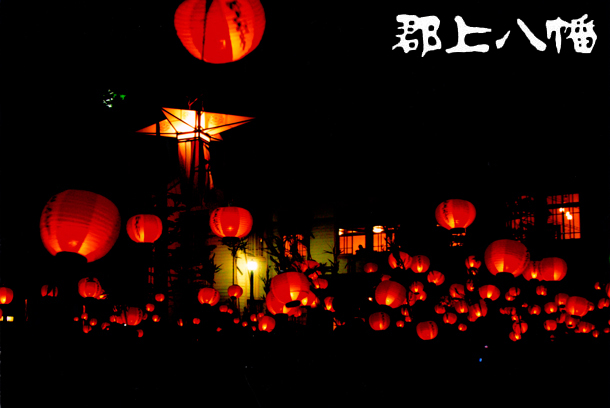
These vintage Gujo Odori instructional videos pay homage to the many Gujo Odori singers, musicians and dancers who dedicated their lives to share their love of Gujo Odori with others. These videos were originally released in the late 1980's and give a slight historic perspective to this timeless bon dance festival.
The most well known of all ten Gujo Odori. The movements are elegant, smooth and easy to follow.
Recalling the Edo period when Gujo Hachiman was a major horse trading centre, the dance movements depict the energetic bucking and jumping movements of a rider on a young horse.
This dance recalls that in 1759, when lord Aoyama came to Gujo Hachiman from Kyoto, he gave the poor farmers each 300 ryo (a unit of currency before the Yen). This song was written by the farmers in gratitude, and the simple movements depict farmers throwing tied bales of harvested rice.
Gujo Hachiman is a castle town, and because of that there used to be many drifting performers who passed through the town. One of these drifting performers wrote Yachiku. Like "Gen gen bala bala", this song is only singing and drums and you may notice a similarity between native North American people’s dance and music. This song is similar to what was performed by street performers in the Edo period.
Danced counter-clockwise, and accompanied only by a singer and a drum, the elegant dance movements depict folding the long sleeves of a young girl’s kimono over her arm as she prepares to play a children's ball game.
Literally translated as "kitten", the simple movements of this dance remind us that cats were very important to farmers in the Edo period. This was when cats were kept by farmers to keep mice and vermin away from the silk worms which were raised to produce high quality silk for which Gujo Hachiman is well-known. Spontaneously invented by the young people of the time, the dance movements of Neko no Ko mimic those of a kitten washing its face with its paws.
A simple and slow paced dance, Sawagi is often danced after the more energetic Haru Koma to allow the dancers the opportunity to recover! Originally sung by geisha, the words are flirtatious with many double entendres. The movements are simple with much hand clapping — a common gesture of many songs and games used by geisha in the entertainment of their guests.
Originally sung by sumo wrestlers in Edo, this song was brought to Gujo Hachiman when sumo wrestling was brought by sumo fans to Gujo Hachiman. The movements depict simple sumo "kata" movements.
Old Kawasaki is the original version of the more modern "Kawasaki" described above. In Gujo Odori, Old Kawasaki is always danced first, and is the only version of Kawasaki danced at mukashi odori or the Old-style Gujo Odori in September. The dance movements are simpler and less elegant than Kawasaki, the accompanying song sadder and slower. The movements depict farmers working in the fields, and the song echoes old work cadence songs that were common in old times.
This is always the last song played of the night; a simple yet poignant song to mark the end of the night's dancing. There is no musical accompaniment. As the singer sings this song, dancers answer "korai, korai" in a gesture of thanks to the singers and musicians for the evening's dancing. Answering the singer with "korai, korai" also serves to equalize the singer with the dancers in a final remembrance of the purpose of Gujo Odori - to bring people together regardless of social class or background.
Visit us in person:
Kinenkan Tourism Centre
501-4222
520-1, Shimadani,
Hachiman Cho,
Gujo Shi, Gifu ken,
Japan
Hours:
9:00 am - 5:00 pm daily
9:00 am - 6:00 pm during Gujo Odori season
Phone: 0575 67-0002